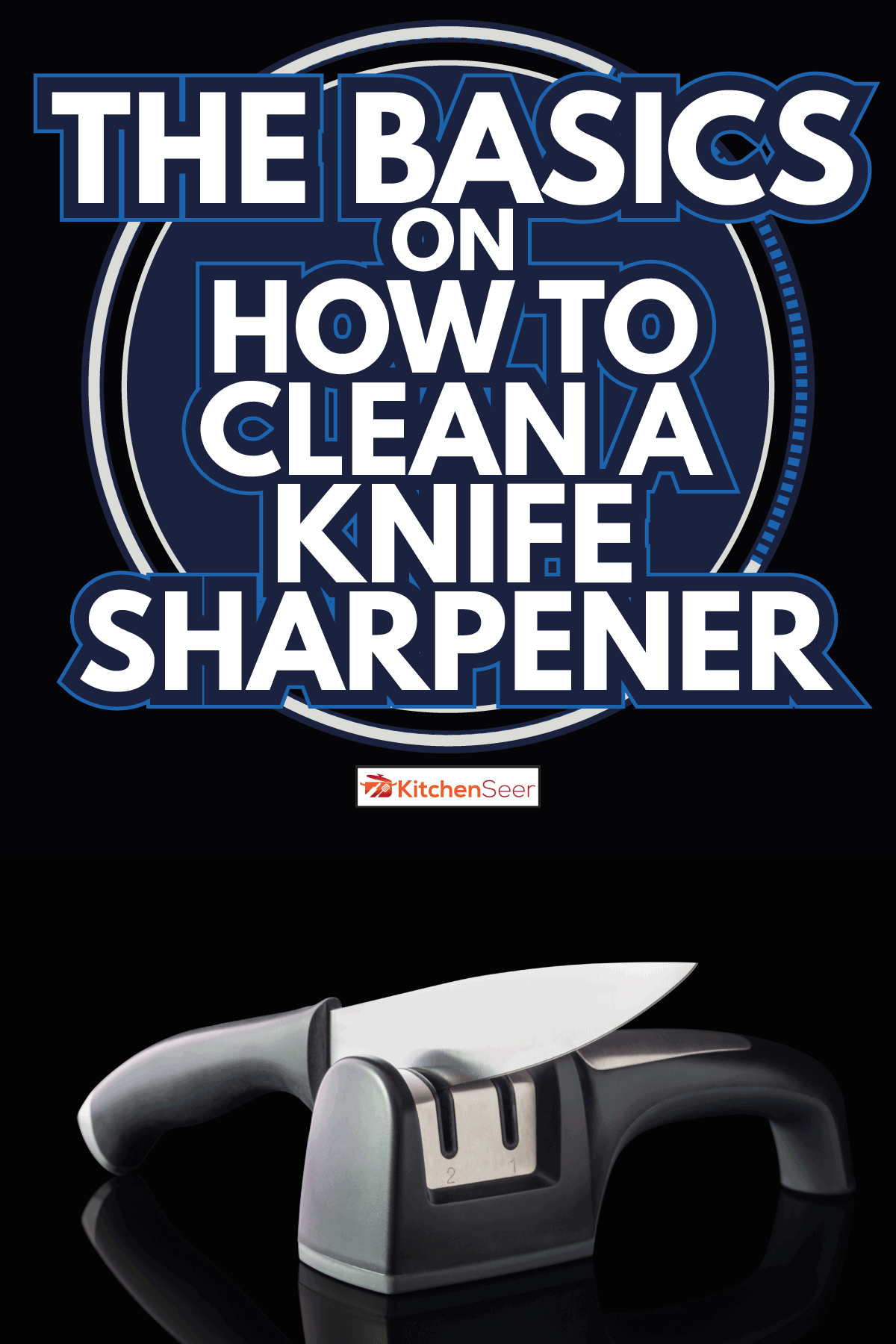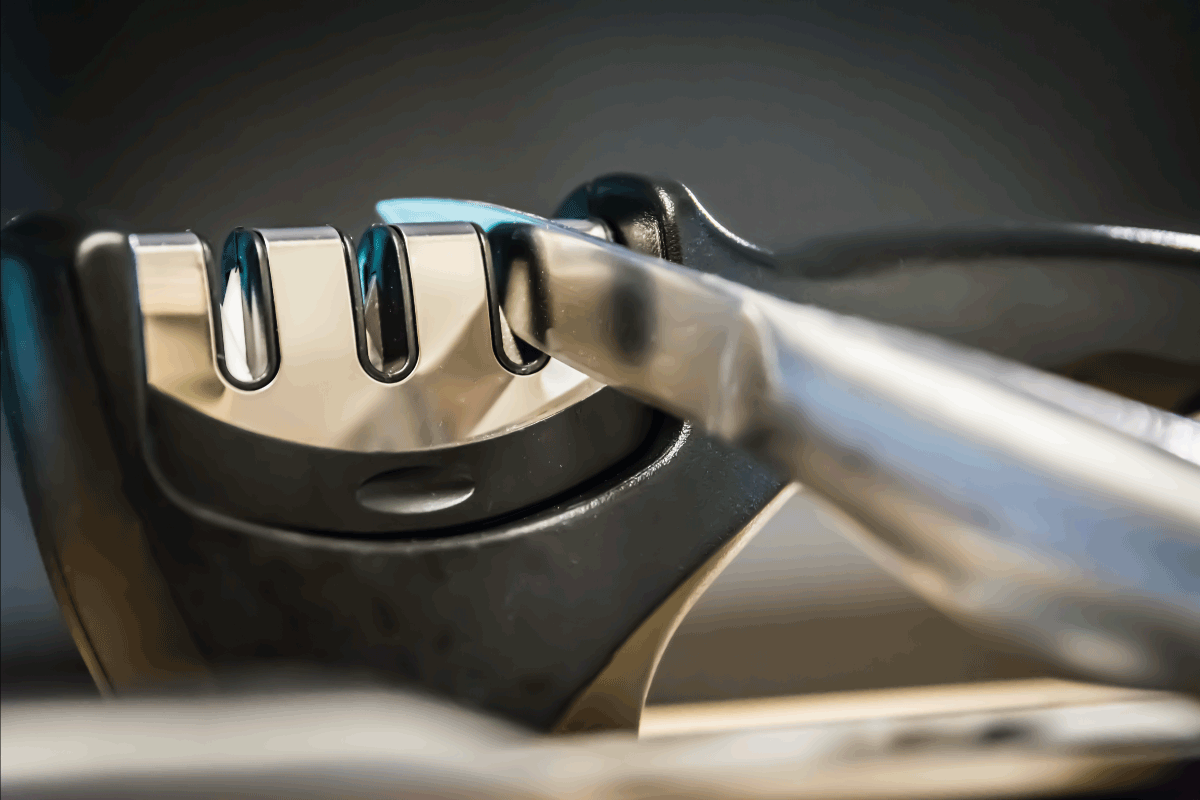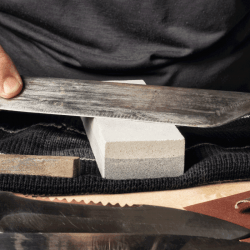Any seasoned chef knows that a knife sharpener is an essential accessory in the kitchen, but what may be a bit foggier is how one should clean this convenient tool. With a variety of options, from sharpening stones and rods to electric sharpeners, you might think that the answer is going to be complicated. Fortunately, it's a relatively simple process.
These are the basic steps of cleaning any knife sharpener:
- Loosen the debris using a cleaning agent such as honing oil or dish soap.
- Scrub away the debris with a brush, magic eraser, or non-metal scouring pad.
- Allow the sharpener to dry completely before continued use.
Sounds easy enough, right? However, you still may have a few questions and would like some more in-depth instructions. Keep reading to learn more.

Loosen The Debris
As you use your knife sharpener, metal and ceramic debris will rub off the knives and onto the sharpener. Over time, this will cause quite a build-up. Not only does this make for a dirty sharpener, but it also makes it ineffective for sharpening, as the debris will prevent it from closely sharpening the knives.
Firstly, you will have to loosen these fragments and shavings so that they will more easily and completely come away from the sharpener's surface. Knife enthusiasts prescribe three cleaning agents for cleansing a knife sharpener.
Honing Oil
Honing oil is an excellent option, and if one owns sharpening stones or abrasive tools, this may already be a product in their stock.
Many sharpeners are porous, meaning that there are holes in their surface where debris may get stuck. Honing oil effectively soaks into the holes and makes a lubricant between the surface and the shavings.
You will have to pour the honing oil onto the sharpener and rub it into the surface. Allow a few minutes for the honing oil to set in and bring shavings to the surface.
Check out this honing oil we found on Amazon.
Dish Soap
If you don't have to hone oil around and you're in a hurry, dish soap is an option that you most certainly have in your kitchen.
To use dish soap on a knife sharpener, you should pour it generously on the surface and rub it into the surface with warm water and a cloth. Just as with the honing oil, allow it to sit for a few minutes and bring the shavings to the surface.
Here's a note about this cleaning agent, though. Since you must use water with it, there is a risk of rust, especially if some metal shavings are left behind. We suggest doing several rounds of this cleaning agent to be sure that all of the fragments have been removed and will not rust in the porous areas of the knife sharpener's surface.
Scrub Away The Debris
After the debris has been loosened, it will need to be scrubbed away from the surface of the knife sharpener and out of its porous holes. Several different tools can be used to do this.
Brush
A brush, such as a dishwashing brush or toothbrush, is perfectly acceptable for the task. We recommend one with soft bristles.
Gently scrub at the surface of the knife sharpener, spending a few minutes on each side. The bristles will work to reach into the porous areas and bring out the filings. You can periodically wipe away the filings with a cloth or paper towel as you clean.
Magic Eraser
The magic eraser can be used for so many things, but we're sure most wouldn't have thought of it for cleaning a knife sharpener. This eraser has a slightly abrasive surface that pulls shavings of any type away from a surface.
Scrub gently at each side of the knife sharpener's surface. Periodically wipe away what is lifted with a cloth or paper towel.
Non-Metal Scouring Pad
The scouring pad is another good tool for cleaning a knife sharpener. We recommend ones made of cloth or foam, as the metal scouring pads may be too abrasive for this task. In addition, cloth pads can be washed, reused, and kept for this purpose.
Take a look at these cloth scouring pads we found on Amazon.
Scrub the surfaces of the knife sharpener with the pad. Once again, you will want to routinely stop to remove the cleaning agent and loosened debris from the surface as you work with a cloth or paper towel.
Dry Completely
Once you have finished scrubbing your knife sharpener, you will want to make sure that as much as possible of the cleaning agent and water, if it was used, has been removed from the surface. This can be done with a lint-free cloth or paper towel.
After this has been done, you may still notice some lingering oil or wetness on the surface. This is to be expected, and not to worry. It will resolve on its own, but the surface must be allowed to dry completely before it is used for sharpening again. We suggest leaving it to dry out for several hours, or ideally, overnight.
How Do You Clean A Ceramic Knife Sharpener?
Cleaning a ceramic knife sharpener is the same process as cleaning a steel knife sharpener.
However, if using a ceramic sharpening system, you will have to disassemble the product before cleaning, and this will have to be done via the product manual's instructions.
Check out this manual knife sharpening system we found on Amazon.
Do Ceramic Knife Sharpeners Wear Out?
The good news is that ceramic knife sharpeners never wear out if used and stored correctly. The bad news is that these sharpeners are pretty fragile due to their material's brittle nature.
Because of this, it's essential that the owner only use it for its proper use, that is, only for sharpening and not for honing. It's also imperative that the owner keep the sharpener in its product case or a cotton bag for storage.
How Do You Care For A Sharpening Stone?
One essential part of caring for a whetstone is by routinely cleaning it as described above, but you must also flatten it as needed with a flattening stone. This must be done to make the stone level, as it will have developed dips and notches from being used to sharpen your knives.
If not done, it will only get worse, making the stone eventually unusable. It could even damage knives when attempting to sharpen.
Check out this flattening stone we found on Amazon.
How Often Should You Flatten A Sharpening Stone?
The frequency at which one must flatten a sharpening stone depends on the type of stone and the individual owner's sharpening experience and technique.
Oil stones, for instance, are made of harder material and thus will wear at a slower rate. Water stones, on the other hand, are softer. They will wear more quickly and therefore will need more frequent flattening to keep their integrity.
Each owner will have a different level of sharpening experience and technique. The time between flattening will be longer for those who have more experience and a more polished technique. For those who are less experienced, however, the stone may need to be flattened more often.
Should I Oil My Sharpening Stone?
This could depend on the type of stone being used. There are water stones and oil stones, and each uses a different lubricant in the sharpening process.
For an oil stone, you should use honing oil while sharpening knives. For a water stone, you should use water. In either case, a lubricant is always needed to protect both the blade and the stone during the sharpening process.

In Closing
Cleaning the knife sharpener is a necessary, though tedious, task that all gormands are faced with from time to time. Thankfully, the procedure is a simple one. You must begin by loosening the debris, then scrub away the debris, and lastly, allow the surface of the sharpener to dry completely before using it again. Keeping your sharpener clean will allow your knives to work their best for you in the kitchen.
Want to learn more about caring for knives? Visit these related posts:
How Often To Sharpen Kitchen Knives?
Do You Need To Wash A Knife After Cutting Bread? [And Other Care Tips For Bread Knives]
How Long Do Kitchen Knives Last?






![knife and old iron sharpener with handle for kitchen knives on a white background, Do Knife Sharpeners Wear Out? [And When To Replace Yours]](https://kitchenseer.com/wp-content/uploads/2021/09/knife-and-old-iron-sharpener-with-handle-for-kitchen-knives-on-a-white-background-250x250.jpg)



